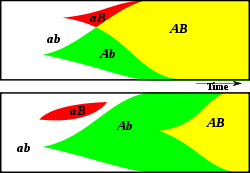- Clonal interference
-
 This diagram illustrates how sex might create novel genotypes more rapidly. Two advantageous alleles A and B occur at random. The two alleles are recombined rapidly in a sexual population (top), but in an asexual population (bottom) the two alleles must independently arise because of clonal interference.
This diagram illustrates how sex might create novel genotypes more rapidly. Two advantageous alleles A and B occur at random. The two alleles are recombined rapidly in a sexual population (top), but in an asexual population (bottom) the two alleles must independently arise because of clonal interference.
Clonal interference is a phenomenon in the population genetics of an asexually reproducing organism. It occurs when two (or more) beneficial mutations arise independently in different individuals in a genetically homogeneous population. In the absence of genetic recombination, the mutations cannot join to form an organism carrying both of them, but they compete against each other. This typically leads to the loss of one of them.[1]
See also
References
- ^ Marianne Imhof and Christian Schlötterer: Fitness effects of advantageous mutations in evolving Escherichia coli populations,Proc Natl Acad Sci U S A. 2001 January 30; 98(3): 1113–1117
Categories:- Population genetics
- Evolution stubs
- Genetics stubs
Wikimedia Foundation. 2010.
